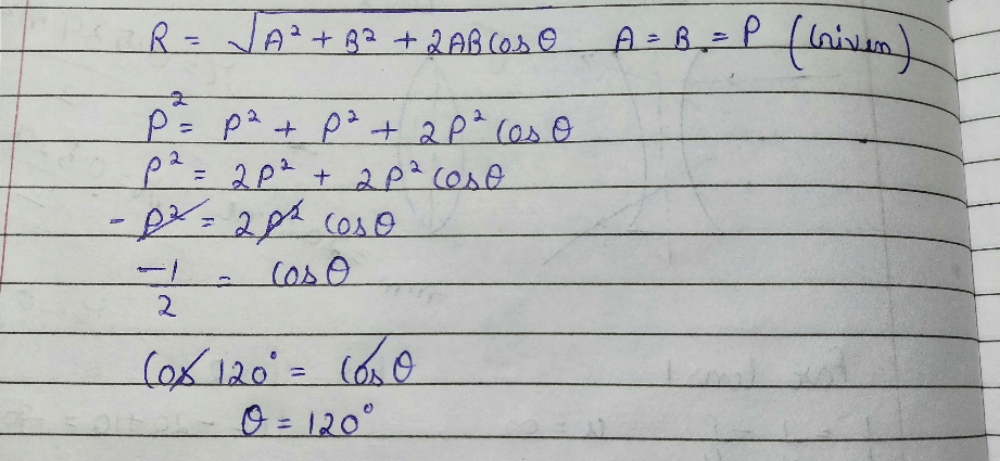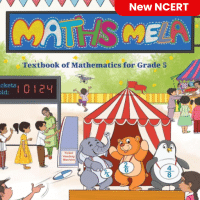Class 5 Exam > Class 5 Questions > If two numerically equal forces P & P act...
Start Learning for Free
If two numerically equal forces P & P acting at a
point produce a resultant force of magnitude P itself,
then the angle between the two original forces is
- a)
- b)
- c)
- d)
Correct answer is option 'D'. Can you explain this answer?
Verified Answer
If two numerically equal forces P & P acting at apoint produce a r...
Most Upvoted Answer
If two numerically equal forces P & P acting at apoint produce a r...

Free Test
FREE
| Start Free Test |
Community Answer
If two numerically equal forces P & P acting at apoint produce a r...
Understanding the Problem
In this scenario, we have two forces, both of the same magnitude, denoted as P. When these forces are applied at a certain angle, they yield a resultant force also equal to P.
Using the Law of Cosines
To find the angle between the two forces, we use the Law of Cosines, which states that for two vectors A and B forming an angle θ, the magnitude of their resultant R can be expressed as:
R² = A² + B² + 2AB * cos(θ)
In our case:
- A = P
- B = P
- R = P
Thus, we can substitute these values into the equation:
P² = P² + P² + 2(P)(P)cos(θ)
Simplifying the Equation
Upon simplification, we have:
P² = 2P² + 2P²cos(θ)
Rearranging gives:
0 = P² + 2P²cos(θ)
This leads to:
-2P²cos(θ) = -P²
Dividing through by P² (since P is not zero), we find:
cos(θ) = -1/2
Finding the Angle
The cosine of an angle being -1/2 corresponds to specific angles on the unit circle. The angle that satisfies this condition is:
θ = 120°
Thus, the angle between the two forces is 120°, confirming that the correct answer is option 'D'.
Conclusion
The forces P and P acting at an angle of 120° produce a resultant force equal to their individual magnitudes, P.
In this scenario, we have two forces, both of the same magnitude, denoted as P. When these forces are applied at a certain angle, they yield a resultant force also equal to P.
Using the Law of Cosines
To find the angle between the two forces, we use the Law of Cosines, which states that for two vectors A and B forming an angle θ, the magnitude of their resultant R can be expressed as:
R² = A² + B² + 2AB * cos(θ)
In our case:
- A = P
- B = P
- R = P
Thus, we can substitute these values into the equation:
P² = P² + P² + 2(P)(P)cos(θ)
Simplifying the Equation
Upon simplification, we have:
P² = 2P² + 2P²cos(θ)
Rearranging gives:
0 = P² + 2P²cos(θ)
This leads to:
-2P²cos(θ) = -P²
Dividing through by P² (since P is not zero), we find:
cos(θ) = -1/2
Finding the Angle
The cosine of an angle being -1/2 corresponds to specific angles on the unit circle. The angle that satisfies this condition is:
θ = 120°
Thus, the angle between the two forces is 120°, confirming that the correct answer is option 'D'.
Conclusion
The forces P and P acting at an angle of 120° produce a resultant force equal to their individual magnitudes, P.

|
Explore Courses for Class 5 exam
|

|
Question Description
If two numerically equal forces P & P acting at apoint produce a resultant force of magnitude P itself,then the angle between the two original forces isa) b) c) d) Correct answer is option 'D'. Can you explain this answer? for Class 5 2025 is part of Class 5 preparation. The Question and answers have been prepared according to the Class 5 exam syllabus. Information about If two numerically equal forces P & P acting at apoint produce a resultant force of magnitude P itself,then the angle between the two original forces isa) b) c) d) Correct answer is option 'D'. Can you explain this answer? covers all topics & solutions for Class 5 2025 Exam. Find important definitions, questions, meanings, examples, exercises and tests below for If two numerically equal forces P & P acting at apoint produce a resultant force of magnitude P itself,then the angle between the two original forces isa) b) c) d) Correct answer is option 'D'. Can you explain this answer?.
If two numerically equal forces P & P acting at apoint produce a resultant force of magnitude P itself,then the angle between the two original forces isa) b) c) d) Correct answer is option 'D'. Can you explain this answer? for Class 5 2025 is part of Class 5 preparation. The Question and answers have been prepared according to the Class 5 exam syllabus. Information about If two numerically equal forces P & P acting at apoint produce a resultant force of magnitude P itself,then the angle between the two original forces isa) b) c) d) Correct answer is option 'D'. Can you explain this answer? covers all topics & solutions for Class 5 2025 Exam. Find important definitions, questions, meanings, examples, exercises and tests below for If two numerically equal forces P & P acting at apoint produce a resultant force of magnitude P itself,then the angle between the two original forces isa) b) c) d) Correct answer is option 'D'. Can you explain this answer?.
Solutions for If two numerically equal forces P & P acting at apoint produce a resultant force of magnitude P itself,then the angle between the two original forces isa) b) c) d) Correct answer is option 'D'. Can you explain this answer? in English & in Hindi are available as part of our courses for Class 5.
Download more important topics, notes, lectures and mock test series for Class 5 Exam by signing up for free.
Here you can find the meaning of If two numerically equal forces P & P acting at apoint produce a resultant force of magnitude P itself,then the angle between the two original forces isa) b) c) d) Correct answer is option 'D'. Can you explain this answer? defined & explained in the simplest way possible. Besides giving the explanation of
If two numerically equal forces P & P acting at apoint produce a resultant force of magnitude P itself,then the angle between the two original forces isa) b) c) d) Correct answer is option 'D'. Can you explain this answer?, a detailed solution for If two numerically equal forces P & P acting at apoint produce a resultant force of magnitude P itself,then the angle between the two original forces isa) b) c) d) Correct answer is option 'D'. Can you explain this answer? has been provided alongside types of If two numerically equal forces P & P acting at apoint produce a resultant force of magnitude P itself,then the angle between the two original forces isa) b) c) d) Correct answer is option 'D'. Can you explain this answer? theory, EduRev gives you an
ample number of questions to practice If two numerically equal forces P & P acting at apoint produce a resultant force of magnitude P itself,then the angle between the two original forces isa) b) c) d) Correct answer is option 'D'. Can you explain this answer? tests, examples and also practice Class 5 tests.

|
Explore Courses for Class 5 exam
|

|
Signup for Free!
Signup to see your scores go up within 7 days! Learn & Practice with 1000+ FREE Notes, Videos & Tests.


















